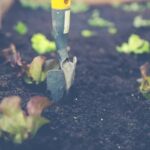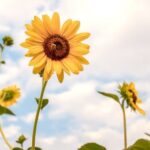Woodland gardens ideas are gaining traction among garden enthusiasts who seek to create a natural, serene oasis in their outdoor space. These gardens mimic the beauty and tranquility of a forest setting, incorporating native plants and attracting wildlife. As urbanization continues to encroach on natural landscapes, woodland gardens provide a connection to nature right in our own backyard.
The allure of woodland gardens lies in their ability to bring a sense of peace and harmony to any outdoor space. By choosing the right location and selecting suitable native plants like ferns, wildflowers, and shade-loving trees, gardeners can easily transform their yard into a lush woodland retreat. The design of these gardens focuses on creating a natural and organic look that blends seamlessly with the surrounding environment.
Beyond aesthetics, woodland gardens also offer environmental benefits by providing habitats for wildlife such as birds, insects, and small mammals. Maintaining these gardens involves regular care and attention, including watering, weeding, and pruning. By incorporating DIY projects like bird feeders or natural stone pathways, gardeners can further enhance the allure of their woodland garden while creating a sustainable ecosystem for local flora and fauna.
Choosing the Right Location
When it comes to creating a thriving woodland garden, selecting the right location is key. Woodland gardens typically require a spot that receives dappled sunlight or partial shade, mimicking the conditions found on the forest floor. Choosing an area with tall trees or shrubs that can provide some shade throughout the day is ideal for these types of gardens. Additionally, consider the soil quality in the chosen location, as woodland plants thrive in rich, organic soil that retains moisture well.
Shade Levels and Soil Quality
Before starting your woodland garden, it’s essential to assess the shade levels in different parts of your yard to determine the best spot for planting. Areas like under mature trees or along north-facing slopes are perfect for creating a woodland garden due to their natural shading.
Moreover, ensure that the soil in your chosen location is well-draining yet rich in organic matter to support the growth of woodland plants effectively. Amending the soil with compost or leaf litter can improve its quality and create a suitable environment for these plants to thrive.
Consider Existing Trees and Landscaping Features
Take into account any existing trees and landscaping features when choosing a location for your woodland garden. Consider how these elements might impact sunlight exposure, water distribution, and root competition for new plantings. Working around established trees can add depth and interest to your garden while providing additional shade and habitat for wildlife. By integrating existing features into your design plan, you can create a harmonious and cohesive woodland landscape that enhances the overall beauty of your outdoor space.
By carefully selecting the right location for your woodland garden based on shade levels, soil quality, and existing features, you can ensure that your garden thrives and flourishes throughout the seasons. Taking these factors into consideration during the planning stages will set you up for success in creating a lush and enchanting oasis inspired by nature’s woodlands.
With proper care and maintenance, your woodland garden will become a tranquil retreat filled with native plants and wildlife for years to come.
Selecting Plants
Woodland gardens are a beautiful addition to any outdoor space, offering a natural and serene environment that can attract various wildlife while providing a peaceful retreat for homeowners. When it comes to selecting plants for your woodland garden, it is essential to choose native species that thrive in shaded areas and mimic the forest floor ecosystem.
Native woodland plants not only require less maintenance but also support local biodiversity by providing food and habitat for animals like birds, butterflies, and insects.
One popular category of plants to include in a woodland garden is ferns. With their delicate fronds and lush green foliage, ferns add texture and depth to the landscape while thriving in shady conditions. Some common varieties of ferns suitable for woodland gardens include lady ferns, ostrich ferns, and maidenhair ferns. These plants can be planted along pathways, around trees, or near water features to create a whimsical and enchanting atmosphere in your garden.
In addition to ferns, incorporating wildflowers into your woodland garden can add pops of color and attract pollinators like bees and butterflies. Woodland wildflowers such as trilliums, bloodroot, and bluebells bloom in early spring when the trees are still bare, brightening up the understory with their vibrant hues.
When selecting wildflowers for your garden, consider choosing species that are adapted to the specific light conditions of your site, whether it be dappled shade or deep shade under dense tree canopy. By carefully selecting a variety of native ferns, wildflowers, and shade-loving trees for your woodland garden, you can create a harmonious plant community that thrives in its natural setting.
| Native Woodland Plant | Description |
|---|---|
| Lady Fern | A delicate fern with lacy fronds that adds texture to shaded areas. |
| Trillium | A spring-blooming wildflower with distinctive three-petal flowers in various colors. |
| Hemlock Tree | A coniferous evergreen tree that thrives in shady environments with soft needles. |
Design Tips
Creating a woodland garden that emanates a natural and organic look involves careful planning and thoughtful design choices. Here are some ideas to help you layout and design your own enchanting woodland garden:
- Pathways: Consider incorporating meandering pathways made of natural materials like wood chips, gravel, or stepping stones to guide visitors through the garden while maintaining the natural feel.
- Seating Areas: Integrate cozy seating areas among the trees or by a tranquil water feature where you can relax and appreciate the beauty of your woodland garden.
- Focal Points: Include focal points such as sculptures, birdbaths, or unique planters strategically placed throughout the garden to draw the eye and add interest.
In addition to these suggestions, you can also experiment with layering plants of different heights to create depth in your woodland garden. Utilize native shrubs and trees as a backdrop, interspersed with mid-height perennials like bleeding hearts or hostas. By mixing textures and colors, you can achieve a visually appealing design that mimics the diversity found in natural woodlands.
To further enhance the natural aesthetic of your woodland garden, consider incorporating elements like fallen logs, rocks, or driftwood artfully placed among your plants. These organic accents not only add visual interest but also provide habitat for beneficial insects and wildlife. With careful planning and attention to detail, you can create a woodland garden that feels like a slice of untouched nature right in your backyard.
Remember that the key to designing a successful woodland garden lies in embracing imperfection and letting nature take its course. Allow plants to self-seed, layer mulch for added protection and moisture retention, and let fallen leaves remain as natural compost. By following these design tips and allowing your creativity to flourish, you can cultivate a beautiful woodland sanctuary that will bring joy for years to come.
Maintaining Your Woodland Garden
Once you have established a beautiful woodland garden, it is essential to maintain it properly to ensure its health and longevity. Regular care and upkeep will help your garden thrive and continue to provide you with a serene natural retreat. Here are some tips on how to maintain your woodland garden throughout the seasons:
1. Watering: Proper watering is crucial for the health of your woodland plants, especially during dry spells. Ensure that your garden receives adequate moisture without becoming waterlogged. Consider installing a soaker hose or drip irrigation system to deliver water directly to the roots of plants.
2. Weeding: Regular weeding is necessary to keep invasive plants at bay and allow your desired woodland flora to flourish. Hand-pull weeds or use mulch to suppress weed growth while still maintaining the natural look of your garden.
3. Pruning: Pruning is vital for shaping plants, removing dead or diseased branches, and encouraging new growth. Be sure to research the specific pruning requirements for each plant in your woodland garden and prune accordingly in the appropriate season.
By incorporating these practices into your regular gardening routine, you can ensure that your woodland garden remains healthy and vibrant throughout the year. With proper care, your woodland retreat will continue to bring you joy and relaxation for years to come.
Remember that creating a woodland garden is an ongoing process that requires patience and dedication. With a little effort and attention to detail, you can enjoy a thriving oasis filled with native plants, wildlife, and natural beauty in your own backyard.
Incorporating Wildlife
In a woodland garden, incorporating wildlife not only adds charm and character but also contributes to the overall ecosystem. By creating a habitat that welcomes various creatures, one can observe the delicate balance of nature up close. One of the simplest ways to attract wildlife is by installing bird feeders throughout the garden.
Different types of bird feeders can attract a variety of avian visitors, from colorful songbirds to majestic woodpeckers. Providing a reliable food source can encourage birds to frequent your garden, adding movement and life to the serene woodland setting.
Another essential element in supporting wildlife in a woodland garden is creating insect hotels. These structures mimic natural habitats for beneficial insects like solitary bees, ladybugs, and lacewings, which play crucial roles in pollination and pest control.
Insect hotels can be made using materials such as hollow bamboo sticks, pine cones, and straw bundled together in sturdy frames. Placing these insect shelters strategically around the garden will not only attract insects but also create educational opportunities for observing their fascinating behaviors up close.
Additionally, incorporating water features into a woodland garden can provide much-needed hydration for wildlife while adding visual interest to the landscape. Birdbaths, small ponds, or even simple shallow dishes filled with water can attract birds, butterflies, and other critters seeking refreshment.
Adding rocks or logs near water sources provides landing spots for thirsty creatures while enhancing the natural beauty of the space. With thoughtful planning and design, a woodland garden teeming with wildlife can become a sanctuary where humans and animals coexist harmoniously amidst lush greenery and blooming flora.
| Wildlife Feature | Description |
|---|---|
| Bird Feeders | Attract various bird species with different types of feeders. |
| Insect Hotels | Create habitats for beneficial insects like bees and ladybugs. |
| Water Features | Add birdbaths or ponds for wildlife hydration and visual appeal. |
Seasonal Interest
Woodland gardens are a beautiful and serene addition to any outdoor space, providing a natural oasis that evolves throughout the seasons. When planning your woodland garden, one key aspect to consider is how to ensure visual interest year-round by incorporating plants with varying flowering times and foliage colors. By strategically selecting flora that bloom at different times and offer diverse hues, you can create an ever-changing tapestry of colors and textures in your woodland garden.
Spring Blooms
Incorporating early blooming plants such as trilliums, bloodroot, and spring ephemerals like Virginia Bluebells can kickstart the visual appeal of your woodland garden as the snow melts away. These delicate flowers add pops of color against the backdrop of awakening trees and shrubs, signaling the arrival of spring in a graceful manner.
Summer Splendor
As the days grow longer and warmer, transitioning to summer blooms will keep your woodland garden vibrant and inviting. Consider introducing native wildflowers like asters, coneflowers, and bee balm for bursts of color that attract pollinators while enhancing the overall aesthetic of your garden. Pair these summer blooming stars with lush green ferns and hostas for a harmonious blend of shades and textures.
Fall Foliage
When autumn approaches, take advantage of the changing foliage colors by incorporating plants that put on a spectacular show as they prepare for winter dormancy. Trees like maple, oak, and dogwood offer stunning displays of reds, oranges, and yellows that can transform your woodland garden into a fiery masterpiece. Pair these colorful trees with late-blooming perennials like sedum or chrysanthemums to extend the visual interest well into the fall season.
By carefully curating a selection of plants with different flowering times and foliage colors in your woodland garden, you can create a dynamic landscape that captivates visitors throughout the year. Embrace the beauty of each season by strategically planning your plantings to ensure a continuous display of nature’s wonders in your very own woodland retreat.
DIY Projects
A woodland garden can be a magical and enchanting space, offering a peaceful retreat in the midst of nature. One creative way to enhance your woodland garden is by incorporating DIY projects that add whimsy and charm to the space. Building a fairy garden is a popular and delightful project that can bring a sense of wonder to your outdoor sanctuary.
You can create miniature landscapes with tiny houses, fairy figurines, and tiny accessories like benches and bridges. These tiny worlds can be tucked into nooks and crannies throughout your woodland garden, inviting both children and adults to imagine the presence of magical beings.
Another fantastic DIY project for enhancing a woodland garden is creating a natural stone pathway. This project not only adds functionality by providing a clear walkway through your garden but also adds visual interest and texture to the landscape.
You can use various shapes and sizes of stones to create a rustic or more polished look, depending on your style preference. The pathways can meander through the trees or lead visitors to different areas of the garden, adding an element of discovery as they explore the space.
Incorporating DIY projects into your woodland garden not only allows you to put your creativity to work but also adds personal touches that make the space uniquely yours. Whether it’s building a fairy garden to infuse magic into your outdoor haven or creating natural stone pathways for added beauty and function, these projects offer endless possibilities for expressing your love for nature in your own backyard.
By taking on these DIY projects, you can transform your woodland garden into an oasis that reflects your personality and brings joy to all who visit.
Conclusion
In conclusion, creating a woodland garden can truly transform your outdoor space into a serene and natural oasis. By carefully selecting the right location, choosing native woodland plants, incorporating wildlife-friendly elements, and maintaining your garden throughout the seasons, you can bring a piece of the forest to your own backyard. The concept of woodland gardens is not just about beautiful aesthetics but also about fostering biodiversity, supporting local ecosystems, and providing a peaceful sanctuary for both humans and wildlife.
One of the key benefits of having a woodland garden is the opportunity to reconnect with nature and escape from the hustle and bustle of everyday life. The calming effect of being surrounded by lush foliage, chirping birds, and buzzing insects can help reduce stress levels and improve overall well-being. Additionally, woodland gardens play an important role in conservation efforts by providing habitats for native plant species and wildlife that may be increasingly threatened by urban development.
As you embark on your journey to create a woodland garden, remember that there are endless possibilities for design and customization. Whether you prefer a more wild and untamed look or a carefully curated arrangement of plants and features, let your creativity guide you.
By following these woodland gardens ideas outlined in this article, you can take the first step towards building your own nature-filled sanctuary right at home. So go ahead, grab your gardening tools and start transforming your outdoor space into a vibrant woodland paradise today.
Frequently Asked Questions
What Is a Woodland Style Garden?
A woodland style garden is a type of garden design that seeks to mimic the natural look and feel of a forest or woodland area. It typically features a mix of trees, shrubs, and perennials that thrive in shaded environments, creating a tranquil and peaceful atmosphere.
What Tree Is Best for Woodland Garden?
When considering the best tree for a woodland garden, it is important to choose one that can thrive in partial shade and moist, well-drained soil typical of wooded areas. Trees like dogwood, redbud, Japanese maple, and flowering cherry are popular choices due to their tolerance for shade and ability to add visual interest throughout the seasons.
What Is the Best Ground Cover for a Woodland Garden?
The best ground cover for a woodland garden is typically a plant that can thrive in shady conditions while helping to suppress weeds and retain moisture in the soil. Some popular ground cover options for woodland gardens include hostas, ferns, wild ginger, foamflower, barrenwort, and sweet woodruff.
These plants not only provide attractive coverage but also contribute to the overall natural aesthetic of the garden.

Welcome to my gardening blog! I am passionate about plants and enjoy sharing my knowledge and experiences with others. In this blog, I will write about everything related to gardening, from tips on how to get started to updates on my own garden projects.





